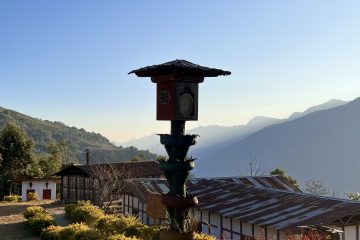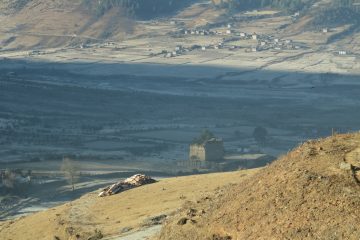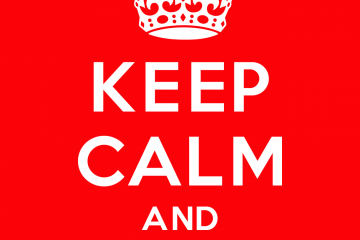There is merriment in the air as the people converse easily, shuffling around and laughing with abandonment. They have come to bring their milk to the community milk collection unit. As some of them ask me to troubleshoot their WeChat accounts or install the Facebook app on their phones, the newcomers join the milling throng, joining in the spontaneous banter. Amidst some light-hearted conversations on the recent drab weather, the weeds infesting the potato fields, and their livestock, the topic of wild dogs come up.
“Talking of cows, the wild dogs are like anything this year. No amount of cowherding is enough to deter them.” Starts one of the bigger dairy-women.
“Yeah, no point taking about these rascals. They even come into our yards after the poor sheep,” adds Choden, a farmer who lives nearby the processing unit.
Everyone wants to speak at once, their frustration clear in their tones. Wild dogs, commonly known as dholes in English, and sabar in the local Hengkha dialect, have been wreaking havoc in the hills and pastures, attacking cattle and sheep left and right. However, unbeknownst to most villagers, these cute doggo-looking canids are actually an IUCN-listed endangered mammal native to Asia. They are an important apex-predator in their habitats, and actually help regulate the populations of wild ungulates such as deer and boars.
For the farmers, however, they are more nuisance than anything else. In retaliation for their ferocious impact on livestock population, a widespread dhole-poisoning campaign was carried out in Bhutan in the 80s. This nearly decimated them but after discontinuing the campaign, their population rebounded, giving local people the impression that the government intentionally introduced them to Bhutan from, you would never have guessed it: the Netherlands! Today, these crafty little beasts have learned to use the steep hillsides to their advantages. They attack livestock grazing on steep slopes far away from the villages. By the time villagers reach the scene, huffing and puffing after lumbering uphill, the sly sabars would already have made fast meals of the poor cows and sheep.

Thus, from the farmers’ perspective, it is a wonder that these dholes never seem to prey on wild games like the feral pigs. After all, the swine bedfellows of the Phobjibs seem as numerous as our domestic herds; every night, a farmer somewhere in the valley loses a potion of his potato to these nocturnal marauders.
“It would be much better if these wild dogs ate the wild pigs, not our good cash cows,” Remarks Lhamo of village Wongseychokpa.
“I think they prefer the meat of our domestic animals which is probably tastier that the boars’ due to all the salt and delicious food we feed to them,” adds Aup Dorji, only half jesting. That could be true; At any rate, they have been feasting on the local stocks. “So much for them being valuable apex predators,” the farmers lament.
“But for the sheep, the feral stray dogs are the worst,” chips in a bemoaning Angay Lemo, a veteran shepherdess of the ancient hamlet of Pisteng. “Up in the hills the wild dogs are bad. But down in the valley, these feral dogs are even worse.”
“Angay, it must be really difficult for you to look after the sheep with all these frisky lamps bobbing about and the stray dogs on their heels,” I cannot help but remark. Angay Lemo is probably 80 years old – too told to herd herd sheep.
Pulling a tired smile, she responds philosophically. “What to do about it? The kids are in school and the able adults are busy with other works.”
Still, it is sad that an old grandmother has to look after a whole flock of sheep with no able helper. Her ancient rheumatic bones must curl at the very thought of running after the dogs. No wonder so many sheep fall easy victim to these nasty feral dogs. And it does not help that these meek little creatures seem to have no wish on their own to live.
It is also sad – and quite honestly, frustrating, that in the name of Tshethar – the practice of saving animals from slaughter – people have been releasing stray dogs into the valley. Left with nothing to eat, these vagabonds resort to preying on calves, sheep and foals. Today, they resemble a new breed of feral canines – ferocious, blood-thirsty and brazen. Rarely a day passes by without a feral dog attacking some poor calves or sheep in the valley.
“If only we could get hands on some rat poisons!” adds another, a burly young man eager to earn a decent living in the high moors. For him, dogs are an anathema.
“That would help us with both the wild dogs and the feral stray dogs.” Agree a few.
“But that would be too sinful,” a few intervene. Memories from last year’s dog-culling program re-surface. It had turned out to be a highly unusual selective cull: all the friendly doggos got killed off but the ferocious attackers remained, procreating and passing their uncouth genes to a new generation of tough feral dogs. In a strange twist of nature vs nurture, humans unwittingly ended up speeding up the process of the selection of the fittest for them.
So far so bad. But the problem is definitely not the inability to get rat poisons or of accruing sin.
On the topic of feral stray dogs, the what to dos are very straight-forward: (1) stop tshethar release of dogs in the valley (2) cull the current feral population. However, the hows are tricky. It becomes a policy, and moral conundrum. Who has power to institute such a no-release policy? Who enforces it? How can it be enforced given our porous border? The dogs are just being animals with survival instincts. Is it okay, especially within the Buddhist milieu, to just kill them off? In addition, people from other areas are incentivized to capture and release stray dogs from their areas into our “big and wide valley.” Conveniently avoid sinning, right? How do we ameliorate this tragedy of commons?
Overall, I think this is an economic dilemma with potential national concern. For years, we have been talking about preserving the sturdier native sheep breed. But if we want the native sheep population to flourish, and the locals to be interested in continuing sheep rearing, there can be no questions asked on the need to cull these pesky rascals, and prevent future release of stray dogs into the valley.
On the topic of the dholes, though, I think the issue is very nuanced as all is not as it seems.
A 2011 study on the seasonal diet of dholes in northwestern Bhutan by Thinley et al found out that dholes consume cattle mostly during the wet season. This, they reason, is due to the winter herding practices of people which make the cattle less accessible to the dholes. In addition, they found that dholes consumed twice as many wild pigs as cattle. In summary, the dholes are ok! We just need to stop feeding our cattle to them.
Let us dissect this by analyzing the “culture” around dairying in Phobjikha.
Firstly, most farmers are smallholders. Farmers want to grow as much potato as they can since it can be very very lucrative if prices and harvest are good. This means that they do not grow enough feeds for the cows since using up more land for growing grasses means less land for growing the more profitable potato. Can we blame the farmers? The math say, not so much. A cattle needs at least an acre of land a year to thrive. Most farmers own an acre or two. A cow or two isn’t enough to put food on the table, send the kids to college and meet the various ends year in, year out.
Thus, with insufficient feeds at home, the cattle have to graze out.
But even if the farmers grow potato on 100% of their land, one to two acres of land isn’t enough to fully subsist on. Thus, the men have to seek work elsewhere and earn wages to make ends meet – often in other valleys and districts. The women now have to do the bulk of the farm works – weeding potato fields, helping neighbors at house construction, attending gatherings and other odds and ends. In simple terms, there is no manpower to spare for herding the cattle against the foxy dholes up in the hillsides.
Plus, our village commons are over-grazed. Being pious Buddhists, we do not cull unproductive cattle. On top of that, cattle from other districts are released by the hundreds into the valley as tshethar. The stock density is simply too high. This forces the poor cattle to seek greener pastures higher up. Incidentally, that is also where the wild dogs live, and it increases the odds of tragic encounters.
But the hillside pastures are not well managed. Some of them are fenced off for tree plantation (more on that in future posts). Invasive bushes, weeds, and bracken take up increasing space and make forage-able plants less available. Since there is no controlled rotational grazing, the choosy cattle walk and trample all over the place, damaging these open-access pastures. They are free to roam as high up as they like, which they like to do. In the proverbial words, they take their neck to where the noose is.
So, how do we solve this multi-faceted “dhole problem”?
I think that we need to transform our entire dairying practices. We need communal rights over the hillside pastures so that we can fence them off, practice controlled, rotational grazing and manage the growth of invasive species such as thistle, bracken, dwarf juniper, and thorn bushes. On top of that, we should enable farmers to rear only a few, highly productive cattle to make more money with less land and resources. In turn, our farmers must be willing to decrease their stock numbers. This can be easily achieved by letting the unproductive members of the herds graze freely and higher up the hillsides so that the dholes can cull them without us having to “sin.”
I may sound ludicrous at the last suggestion. However, it is important to realize that these are economic questions we have to confront realistically. If the dhole problem persists (and it will if we continue business-as-usual), our farmers could lose the best cattle to them. Consequently, their incentive to carry out dairy farming will decrease as, literally speaking, their cash cows get eaten up for naught.
On the part of the government and the land authorities, I honestly expect the concerned persons to understand the fundamental need for communal rights over the pastures so that we can better manage them for greater productivity. I say, please understand that the goal of national food self-sufficiently is only a dream if farmers can farm enough land to first feed themselves, and then feed others. It sounds cliched, but this pandemic has shown us that we need a greater level of food sufficiency as a nation.
Ultimately, it is a question of empowering our rural dwellers – the 60% of Bhutan who contribute to less than 12% of Bhutan’s GDP. In and of themselves, these stats speak a lot about agricultural productivity and the rural-urban wealth divide in Bhutan. More on this later, I hope.



0 Comments